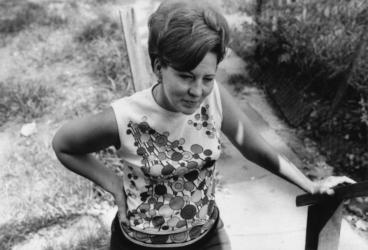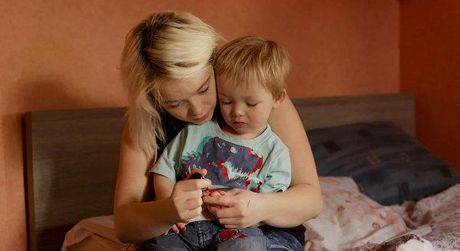
Josephine Decker, director of the 2018 experimental drama Madeline’s Madeline, said in an interview that while studying literature in college, she became “obsessed with this concept of the narrator.”[i] She was drawn to epic novels (like One Hundred Years of Solitude by Gabriel García Márquez or Fyodor Dostoevsky’s The Brothers Karamazov) that toyed with the idea of reliable or objective narrators. Even in the absence of a filmic narrator in a more traditional sense (via voiceover or asides to the audience), the subjective perspective of Madeline’s Madeline is palpable from the very first scene. The film begins with the camera seeing from the perspective of Madeline (Helena Howard) during an acting exercise; she looks through a mask at a nurse who whispers, “The emotions you are having are not your own. They are someone else’s.” We are immediately reminded that we are watching someone’s story unfold from the inside out, which begs the question: What does it mean for something to be your “own,” or to “own” an emotion at all?
The viewer becomes not just a spectator but a participant in the act of narrative creation, as the camera seems to see through Madeline’s eyes for a brief period. She is a talented teenage acting student in an avant-garde New York theatre troupe, and as the troupe’s piece is devised, she embodies any number of characters—a cat or a sea turtle among her favorites—and performs their emotions, feels their emotions. These performances are captured by the dizzying cinematography of Ashley Connor and create the impression of traveling through a murky unconscious. Madeline’s world often slips into a hazy blur of colors and voices and faces so that it becomes unclear what belongs to reality and what belongs to her imagination.
For much of Madeline’s Madeline, the protagonist is not entirely in control of the work she creates as an actor—and it’s not even clear how much of what she performs belongs to her own life story. Madeline’s identity is constantly being cannibalized by those around her, as her maternal figures—the theatre troupe’s director Evangeline (Molly Parker), and Madeline’s actual mother Regina (Miranda July)—start to exert competing claims over her personhood. Madeline has a history of unspecified mental illness for which she takes medication (though she has let the prescription run out), and her mother struggles to communicate with her effectively. Evangeline becomes increasingly exploitative of this tense mother-daughter relationship, incorporating pieces of Madeline’s real life into the theatre piece and using Madeline’s pain in service of her own art. “I’m really interested in people who are out of control of their circumstances,” Evangeline says at one point, an indirect yet still pointed jab at Madeline. Evangeline is firmly placing herself in control of both her personal circumstances and Madeline’s, trying to take the power away from Madeline in telling her own story.

Janie’s Janie, a 1971 Newsreel Collective documentary, also wrestles with the topic of control—this time the subject is a working-class woman in Newark, New Jersey named Janie Giese. The film,[i] made by Geri Ashur, Peter Barton, Marilyn Mulford and Stephanie Palewski, documents Janie’s journey to take back control of her life after decades of abuse at the hands of her father and husband. She shares her experience separating from her husband Charlie, caring for her five young children, and navigating the welfare system and the early 1970s women’s movement. While Janie’s Janie and Madeline’s Madeline diverge in style and subject matter, their title constructions reveal a shared focus on women trying to tell their own stories. Janie narrates her life story via interviews, speaking frankly to the camera about her adolescence and marriage, putting motherhood in her own words as she chats while wiping down the counters or helping her children get dressed. Janie describes her journey toward self-possession and is finally able to see that she is not property to be owned by another: “First I was my father’s Janie, then I was my Charlie’s Janie, now I’m Janie’s Janie.” She owns herself, her name, her body, her life.
Janie is more immediately self-assured than Madeline—not only does she have the opportunity to speak directly to the camera, she also has the benefit of having already come of age. Madeline is still in the depths of adolescence, exploring her sexuality, her acting craft, and her relationship with her mother. She must also deal with intense scrutiny over her racial identity. Both Evangeline and Regina are white women, while Madeline is biracial (her Black father remains absent in the film). Evangeline’s work constantly threatens to cross into appropriative and exploitative territory, and often does cross into it in her interactions with Black bodies as she mines their cultural capital for her own use. In one scene, a Black man named Jamal tells the circle of actors about his two years in prison, and they ask him questions about his experience. Evangeline follows by asking the group: “Does anyone else have an experience or a moment of violence that’s happened to them that they might want to share?” Then, they begin an improvisation on the theme of “no way out,” rooted in Jamal’s experiences. Evangeline takes the story of an individual and riffs on it, turning it into her own artistic work. The actors are understandably confused most of the time by what they’re doing; most don’t seem to have a clue as to what it is they are creating. “Is prison a metaphor? What are we making?” they ask, though Evangeline demurs, not giving much explanation about her artistic vision.

What story, whose story, and whose work the “work” is about becomes even more murky as Madeline’s Madeline goes along. The troupe’s acting style is histrionic and showy—actors wear grotesque pig masks and move with feral ferocity—but it never becomes clear what exactly the piece is that they are developing. The end result of their labour is being obscured—they are told to just keep working and to trust in the vision. The actors constantly have their own agency delegitimized, their individual identities subsumed by the whole. In Janie’s Janie, Janie states bluntly in an interview that those in power do not want those living in poverty to know that they have rights: the working class must become submissive and invisible. As a white woman, Janie also slowly grows more aware of racial injustices; she has learned the importance of viewing people not as stereotypes, but instead “for themselves.” She develops a greater feminist consciousness and class consciousness, learning how to advocate for herself while dealing with the telephone company and the community daycare. [iii] These women are not simply labour for another to exploit, nor things to be owned. Janie is not paid for her domestic work, and it seems that Madeline acts in the theatre troupe for free. They are asked to give their all, expected to give every emotion and life story, without receiving anything in return.
These films ask us to see women as they see themselves, a view that is far too often suppressed.
Evangeline keeps throwing around the word “metaphor” to describe the work the actors are doing: “It’s a metaphor,” she says, whenever anyone probes for the themes of the work, perhaps to make it seem deeper and more intentional; “It’s just a metaphor,” she says later, perhaps to deter suspicion that the work is taking anyone’s story verbatim. Prison is a metaphor, mental illness is a metaphor, Madeline’s experience while acting is a metaphor. But a metaphor for what? This question is never satisfyingly answered. Later, Madeline performs an intensely personal improvisation based on her relationship with her mother. The rest of the troupe is shocked by the outpouring of raw emotion, but Evangeline’s immediate reaction is to incorporate the story into their theatre piece. “It’s her story. It’s my story. It’s everyone in this room’s story,” she says to justify her actions. The rest of the troupe is utterly baffled by this, and jumps into a protective stance around Madeline: is her reality about to become their theatre piece? Can they really tell her story… and should they? Evangeline’s actions verge on identity theft, using pieces of Madeline for her own financial or artistic benefit. She continues to insist that the story isn’t Madeline’s, but Zia’s (Zia is Madeline’s character, whose name Madeline chose herself). Yet as Evangeline keeps talking, Madeline remains noticeably silent, unsure how to respond. How can someone who is not Madeline say what her story is, what being “Madeline” means? At another point in the film, Madeline, when asked to “be herself,” defiantly declares: “You don’t know myself. I am being myself.” She’s being herself. Her self. Madeline’s Madeline. Her acting is her craft, her escape, her act of self-creation, her definition of identity.

Evangeline’s and Charlie’s resistance to relinquishing their singular authority over the two titular women pushes Madeline and Janie to refashion how they see themselves in relation to the world. After years of being basically trapped in the house and in her marriage, Janie felt that there was nobody who cared about her or asked if her life was making her happy: “I didn’t even know if there was another person alive out there in that world.” The titles Janie’s Janie and Madeline’s Madeline convey a similar sense of solipsism, of being inside these women’s heads and seeing them as they see themselves. In the final shot of Madeline’s Madeline, Madeline stands alone in the street. Maybe nobody else is there, or maybe nobody else matters; all we can know for certain is that Madeline and Janie exist. As much as they might have it pounded into their heads that they’re not enough, these women are resilient; for them to assert ownership over their own identities within systems of unequal power—whether that be the hierarchy of a theatre troupe or of a patriarchal society—is a radical move. These films ask us to see women as they see themselves, a view that is far too often suppressed.





